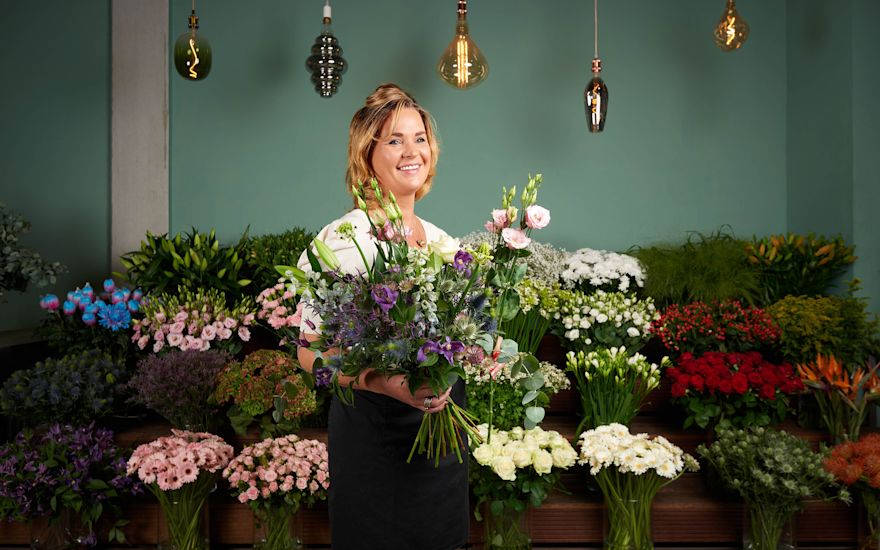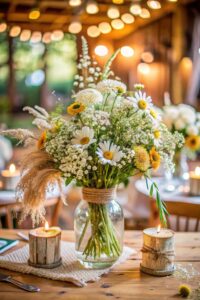The most in-demand floral greens for Fall 2025 include Robellini palms and Italian Ruscus, alongside versatile staples like Israeli Ruscus, Salal, Nagi, Olive, and Eucalyptus. It offers airy texture and dramatic height for arches and large installations. At the same time, Ruscus remains a favorite for its long, trailing stems that create natural elegance in bouquets and runners.
Wholesalers should focus on bunches with 5–10 stems, lengths of 24–36 inches, and vase lives of 7–10 days. Pairing fresh greenery with preserved and bleached options will help designers create durable, trend-aligned looks for the season’s weddings and events.
Why Greens Matter More Than Ever in Fall 2025
Greenery has shifted from being a simple filler to becoming one of the defining design elements in modern floral work. For Fall 2025, event florists and wedding designers are leaning into lush, sculptural arrangements that let foliage take center stage. Instead of hiding in the background, greens now set the tone of an installation, framing flowers and enhancing seasonal palettes.
This fall, palettes are expected to focus on jewel tones like garnet, emerald, and sapphire, mixed with earthy neutrals that ground the look. To complement these colors, greenery needs to provide not only volume but also shape, texture, and movement. Robellini palms, with their wispy fronds, add an airy, architectural feel. Italian Ruscus, with its glossy trailing stems, delivers elegance and flow. Supporting greens like Israeli Ruscus, Salal, and Eucalyptus continue to play crucial roles, but the demand for specific statement greens is higher than ever.
For wholesalers, stocking an assortment of these trending greens is more than just good business—it ensures floral professionals have the tools to create the most in-demand greenery types for fall floral wholesalers.
Spotlight on Robellini (Phoenix roebelenii)
Entity: Robellini Palm / Phoenix roebelenii
Robellini, often called the dwarf date palm, is quickly becoming a favorite greenery choice for fall events. Its long, feather-like fronds create volume without feeling heavy, and the subtle movement of the leaves adds a natural sense of life to large installations. While tropical in origin, it blends surprisingly well with the moody, dramatic designs popular for fall weddings.
- Stem Length: 20–30 inches
- Look & Feel: Airy, feathery, elegant
- Best Uses: Ceremony arches, stage backdrops, tall centerpieces
- Longevity: 7–10 days with hydration
Designers love it because it can instantly transform a space. Whether framing an archway or cascading from a hanging structure, it offers scale without overwhelming the flowers. Wholesalers should note that Robellini is especially valuable for event installs that require volume at a reasonable price point, making it a smart choice to stock in bulk.
Spotlight on Italian Ruscus
Entity: Ruscus aculeatus (Italian variety)
Ruscus is a true workhorse of the floral industry. Long stems with thin, elegant leaves make it the go-to greenery for creating garlands, table runners, and trailing bouquets. Its subtle shine adds polish, and its flexibility means it can be used fresh or allowed to dry slightly for textural garlands.
- Stem Length: 24–36 inches
- Bunch Size: Typically 5 stems per bunch
- Longevity: 7–10 days (sometimes longer with proper conditioning)
In Fall 2025, Ruscus continues to lead demand because it pairs seamlessly with both boho-inspired fall palettes and modern luxury looks. Florists often reach for it first when creating greenery garlands for long farm tables or lush backdrops. Its ability to drape naturally makes it a perfect partner for statement florals like dahlias, chrysanthemums, and roses, all of which dominate fall arrangements.
Greens Comparison Table (Wholesale Specs)
While Robellini and Ruscus are stars, it’s worth comparing them to other fall greenery staples. Each green serves a distinct role, and wholesalers who stock a variety ensure that florists have the flexibility to create balanced, layered designs.
| Greenery Type | Stems per Bunch | Avg. Stem Length | Vase Life | Best Uses | Seasonal Demand |
| Robellini | 10–15 | 20–30″ | 7–10 days | Arches, backdrops | Rising for fall installs |
| Italian Ruscus | 5 | 24–36″ | 7–10 days | Runners, bouquets | Always high |
| Israeli Ruscus | 10 | 20–28″ | 10–14 days | Garlands, filler | Steady |
| Salal (Lemon Leaf) | 20–25 | 15–20″ | 7–10 days | Bouquets, bases | Strong for fall |
| Nagi | 8–10 | 20–25″ | 7–10 days | Textured designs | Moderate |
| Olive | 10 | 24–30″ | 7–10 days | Rustic/organic looks | Peak fall |
| Eucalyptus (Seeded/Silver Dollar) | 5–10 | 18–28″ | 7–14 days | Tables, bouquets | High |
Design Recipes with Robellini & Ruscus
Florists and event designers often want practical “recipes” they can follow. By showing exactly how much greenery is needed for common installs, wholesalers can position themselves as not just suppliers, but partners in design success.
1. Fall Ceremony Arch
The current total of ~45 stems is far too low for a dramatic arch.
For a 7–8 ft arch, plan ~150–250 stems total, depending on whether it’s full or asymmetrical coverage.
- Greenery: ~80–120 stems (Italian ruscus, Israeli ruscus, salal, or olive for body).
- Palms/Fronds: ~10–20 Robellini for texture and scale.
- Blooms: ~40–80 stems (garden roses, burgundy dahlias, mums, spray roses).
- Accents: ~12–24 pampas plumes + fall elements like amaranthus or grasses.
- Mechanics: Note how many cages, ties, or water sources are needed.
Please clarify arch size and coverage (full vs. corner spray).
2. 10-Foot Table Runner
- “15 ruscus + 10 olive” isn’t enough for lush coverage.
- Plan ~6–10 bunches total (~60–100 stems) of mixed greenery like ruscus, olive, and eucalyptus.
- Alternatively, specify a 10-ft premade garland (order 12–15 ft for drape/overhang).
- Seasonal accents (mini gourds, taper candles, dried wheat) should be given in quantities per 2–3 ft so placement looks balanced.
3. Jewel-Tone Bridal Bouquet
Current recipe lists mostly greenery without flower counts.
A proper bouquet needs ~25–40 blooms + 10–15 greenery stems for a medium-to-full look.
- 6–8 garden roses
- 3–5 dahlias
- 5–7 ranunculus
- 3–5 spray roses
- 3–5 accent blooms (scabiosa, mums, carnations)
- 10–15 stems Italian/seeded eucalyptus for drape
Please also note finishing touches (ribbon length/style) and approximate bouquet size.
Fresh vs. Preserved Greens
An important shift for 2025 is the rise in preserved and bleached greens. These add longevity and versatility, especially for large installations that must hold up for days. Preserved Ruscus, for instance, is becoming a favorite for arches and hanging installs where durability is key. Bleached Olive and Eucalyptus provide a muted, textural look that aligns perfectly with fall’s rustic-luxury aesthetic.
For wholesalers, offering both fresh and preserved options expands your market. Designers who once relied only on fresh now use hybrid approaches, mixing the two to reduce waste and cost while enhancing texture.
Conditioning & Care Checklist
Even the best greens can disappoint if they’re not handled correctly. Wholesalers should remind buyers to:
- Unpack immediately to prevent wilting.
- Hydrate thoroughly by re-cutting stems at an angle and using floral preservative.
- Store at the right temperature (36–38°F) to prolong life.
- Plan installs strategically, ideally 1–3 days before the event.
- Leverage natural drying, Ruscus often keeps well even after water is gone, making it great for garlands.
This not only protects the investment but ensures florists can deliver stunning, long-lasting designs.
Ordering & Logistics Tips for Wholesalers
Seasonal demand can overwhelm unprepared suppliers. To stay ahead, consider these strategies:
- Stock early: Florists typically order 3–4 days before an event, so keep consistent inventory in September through November.
- Encourage substitutions: Offer Israeli Ruscus or Cocculus as alternatives when Italian Ruscus sells out.
- Bundle products: Pre-packaged “Runner Packs” (Ruscus + Olive) or “Arch Packs” (Robellini + Israeli Ruscus) simplify buying.
- Communicate clearly: Provide designers with stem count guidance so they know exactly how many bunches to order for specific projects.
These small touches elevate you from supplier to trusted partner, building loyalty among repeat buyers.
FAQs
- How many bunches of Ruscus are needed for a 10-foot garland?
Usually 3–4 bunches (15–20 stems), depending on how lush you want the look. - What’s the difference between Italian and Israeli Ruscus?
A: Italian Ruscus trails elegantly and is ideal for runners. Israeli Ruscus stands upright and is sturdier, making it better for garlands and structural work. - How long do fronds last?
A: They typically last 7–10 days with proper hydration, but can last longer in cooler conditions. - Are preserved greens worth it?
A: Yes. Preserved Ruscus and bleached greens are becoming staples for designers, especially when they need durability and unique textures.
Final Thoughts
As Fall 2025 approaches, greens are not just fillers; they’re statement-makers. Robellini and Italian Ruscus lead the charge, supported by olive, eucalyptus, and other versatile foliage. Wholesalers who adapt by offering both fresh and preserved options, clear ordering guidance, and bundled solutions will be the ones florists return to season after season.
By going beyond the basics and providing trend insight, spec sheets, and design guidance, you don’t just sell greens, you help florists create the unforgettable fall events their clients dream of.




